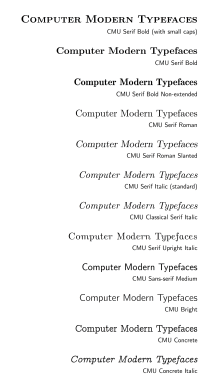Computer Modern
 | |
| Category | Serif |
|---|---|
| Classification | Didone |
| Designer(s) | Donald Knuth |
 | |
| Sample | |
Computer Modern is the original family of typefaces used by the typesetting program TeX. It was created by Donald Knuth with his Metafont program, and was most recently updated in 1992.[1] Computer Modern, or variants of it, remains very widely used in scientific publishing, especially in disciplines that make frequent use of mathematical notation.
Design
As implied by the name, Computer Modern is a "modern" serif font, a genre that emerged in the late 18th century as a contrast to the more irregular designs that preceded them. Modern, or "Didone", fonts have high contrast between thick and thin elements, and their axis of "stress" or thickening is perfectly vertical. Computer Modern, specifically, is based on Monotype Modern 8a, and like its immediate model it has a large x-height relative to the length of ascenders and descenders. Monotype Modern was used extensively for printing mathematics before the arrival of Times New Roman, which publishers began to use after the 1950s.[2][3][4] Its selection as a default font for TeX exemplifies Knuth's desire to return to the glories of classic metal-type printing.[5]
The most unusual characteristic of Computer Modern, however, is the fact that it is a complete type family designed with the Metafont system. The Computer Modern source files are governed by 62 distinct parameters, controlling the widths and heights of various elements, the presence of serifs or old-style numerals, whether dots such as the dot on the "i" are square or rounded, and the degree of "superness" in the bowls of lowercase letters such as "g" and "o". This allows Metafont designs to be processed in unusual ways; Knuth has shown effects such as morphing in demonstrations, where one font slowly transitions into another over the course of a text.[6] Computer Modern is by no means the only Metafont-designed typeface, but it is by far the most mature and widely used.
Derived versions

Knuth produced his original Computer Modern fonts using Metafont, a program that reads stroke-based definitions of glyphs and outputs ready-to-use fonts as bitmap image files.
The advance of publishing technology (PostScript, PDF, laser printers) has reduced the need for bitmap fonts. The preferred formats are now outline fonts such as Type 1, TrueType, or OpenType, which can be rendered efficiently at arbitrary resolution and using sophisticated anti-aliasing techniques by printer firmware or on-screen document viewers. Therefore, several other projects have ported the Computer Modern fonts into such formats. Some of these projects have also complemented Computer Modern with
- additional characters (euro, accented characters, Cyrillic and Greek script coverage)
- different font encodings (to overcome problems with Knuth's original 8-bit character sets)
- additional font style variants
Several such derivatives are now also widely used and included in TeX Live, a modern TeX distribution.
A current extended release of the Computer Modern family in the general-purpose OpenType format as the CMU distribution (link below) includes:
- CMU Serif, the main Computer Modern font family. This includes the four traditional styles of font (regular, italic, bold, bold italic), and also:
- CMU Serif upright italic, an upright italic style similar to cursive upright handwriting
- CMU Serif bold non-extended, a bold weight duplexed to have the same width as the regular style
- CMU Serif roman and bold slanted, two oblique styles
- CMU Classical Serif, an italic design with slightly simpler serif designs
- Concrete Roman, a slab serif font in the four standard styles
- CMU Typewriter, a typewriter-style slab serif font
- CMU Sans Serif, a complementary sans-serif font, and CMU Bright, a lighter style of the same design
- CMU Sans demi-condensed, a condensed style of the same design
BlueSky
Computer Modern was first transformed to a PostScript Type 3 font format by BlueSky, Inc. in 1988, and then to Type 1 in 1992 to include font hinting.[7] The Type 1 version has since then been donated to the American Mathematical Society (AMS) which distributes them freely under the Open Font License.[8] It is found in most standard TeX distributions.
Latin Modern
The Latin Modern implementation, maintained by Bogusław Jackowski and Janusz M. Nowacki, is now standard in the TeX community and was made through a Metafont/MetaPost derivative called METATYPE1. It was derived from the BlueSky Type 1 fonts, which were converted back into outline-based METATYPE1 programs, from which then the extended Type1 and OpenType Latin Modern fonts were developed. ConTeXt uses Latin Modern as default font, instead of Computer Modern[9]
The Type1 to METATYPE1 to Type 1 roundtrip conversion process involved in the production of the Latin Modern fonts did try to preserve the hinting information of the BlueSky fonts, however it added rounding errors that do affect the quality of the hinting at low pixel sizes. As a result, on-screen display of the Latin Modern fonts can result in a less even display of kerning and character heights than is the case with the BlueSky fonts.[10]
The same process was later extended to some free PostScript font clones under the umbrella project called TeX Gyre.[11]
The Latin Modern font has also gained an OpenType math table.[12][13]
Others
- EC fonts – look much like Computer Modern, but have slightly different metrics. These were the first TeX fonts to use the "Cork encoding" (in LaTeX also known as T1 encoding) that provides precomposed glyphs for West-European languages. The original EC fonts were only available as Metafont generated bitmaps.
- TC fonts – the TeX Companion fonts provide a number of additional symbols commonly used in text.
- BaKoMa fonts – another automatically generated Type1 version of Computer Modern by Basil K. Malyshev.
- CM-super[14] – a very large extension of Computer Modern, available in a variety of encodings. These fonts were automatically vectorized from Computer Modern or EC font bitmaps and therefore lack the hinting information in the BlueSky fonts.
- CM-LGC – a Latin, Greek, Cyrillic extension
- GUST [15] – adding many diacritics, and Vietnamese
See also
- STIX Fonts, a project to create Times New Roman-compatible mathematics fonts. Open-sourced under the SIL open font license.
- Surveyor, a general-purpose commercial font by Tobias Frere-Jones. In the same style to Computer Modern Serif but with a wider range of styles, weights and optical sizes.[16]
References
- ↑ "Knuth: Message about TeX fonts". Cs-faculty.stanford.edu. Retrieved 2015-06-12.
- ↑ Daniel Rhatigan, The Monotype 4-line System for Setting Mathematics
- ↑ Daniel Rhatigan, Three Typefaces for Setting Mathematics
- ↑ T. W. Chaundy, P. R. Barett, Charles Batey, The Printing of Mathematics, Oxford University Press (1954, 1957)
- ↑ Knuth, Donald (1986). "Remarks to Celebrate the Publication of Computers & Typesetting" (PDF). TUGboat. 7 (2): 95–8. Retrieved 24 September 2015.
- ↑ Knuth, Donald (1982). "The Concept of a Meta-Font" (PDF). Visible Language. 16 (1): 3–27. Retrieved 25 September 2015.
- ↑ "Blue Sky Research and Computer Modern fonts". Math.utah.edu. 1997-12-04. Retrieved 2015-06-12.
- ↑ "The Adobe Type 1 fonts, previously known on CTAN archives as the "bluesky" fonts, are now distributed as part of the AMS fonts distribution, at CTAN:fonts/amsfonts". Ctan.org. Retrieved 2015-06-12.
- ↑ "FAQ - ConTeXt wiki". Wiki.contextgarden.net. Retrieved 2015-06-12.
- ↑ "A E F and T sized differently in lmodern pacakge? • Fonts & Character Sets • LaTeX Community". Latex-community.org. Retrieved 2015-06-12.
- ↑ "The New Font Project : TEX Gyre" (PDF). Tug.org. Retrieved 2015-06-12.
- ↑ "The Latin Modern Math (LM Math) font — GUST" (in Polish). Gust.org.pl. Retrieved 2015-06-12.
- ↑ "Package lm-math". Ctan.org. 2014-09-05. Retrieved 2015-06-12.
- ↑ "tex-archive/fonts/ps-type1/cm-super". Ctan.org. Retrieved 2015-06-12.
- ↑ "The Latin Modern (LM) Family of Fonts — GUST" (in Polish). Gust.org.pl. Retrieved 2015-06-12.
- ↑ Frere-Jones, Tobias. "Surveyor". Hoefler & Frere-Jones. Retrieved 24 September 2015.
Further reading
- Donald E. Knuth, Computers and Typesetting Volume E: The Computer Modern Fonts, Addison-Wesley, Reading, Mass. 1986 Hardcover: ISBN 0-201-13446-2, Softcover: ISBN 0-201-60660-7